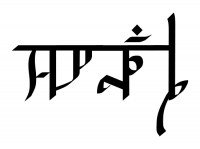Difference between revisions of "Jhukhaulya"
Trismegistus (talk | contribs) m |
Trismegistus (talk | contribs) m |
||
| Line 1: | Line 1: | ||
| − | The ruins of ancient Jhukhaulya rest at the end of the [[Tulampta Peninsula]] on the western shore of [[Lake Vimala]]. Jhukhaulya was founded in the late fourth millennium before [[Salmakhamer]] as the capital of the [[Neibhu-Yona Kingdom]]. It was abandoned during the [[Surizhah Kingdom]] and restored as capital during the [[Jatha-Nebir Kingdom]], the last of the eleven Kalaman kingdoms. The ruins were known since antiquity, but the associated necropolises were not discovered until modern times. In keeping with ancient Kalaman practice, the burial site of the Kings of Kalama was held in a separate location, possibly from public knowledge, and venerated as sacred, from the site of the capital city. | + | The ruins of ancient Jhukhaulya rest at the end of the [[Tulampta Peninsula]] on the western shore of [[Lake Vimala]]. Jhukhaulya was founded in the late fourth millennium before [[Salmakhamer]] as the capital of the [[Neibhu-Yona Kingdom]]. It was abandoned during the [[Surizhah Kingdom]] and restored as capital during the [[Jatha-Nebir Kingdom]], the last of the eleven Kalaman kingdoms. The ruins were known since antiquity, but the associated necropolises were not discovered until modern times. In keeping with ancient Kalaman practice, the burial site of the [[Kings of Kalama]] was held in a separate location, possibly from public knowledge, and venerated as sacred, from the site of the capital city. |
[[File:HirgunyaScriptJhukhaulya.png|thumb|200px|Hirgunya Script of the name "Jhukhaulya"]] | [[File:HirgunyaScriptJhukhaulya.png|thumb|200px|Hirgunya Script of the name "Jhukhaulya"]] | ||
Latest revision as of 15:26, 9 May 2015
The ruins of ancient Jhukhaulya rest at the end of the Tulampta Peninsula on the western shore of Lake Vimala. Jhukhaulya was founded in the late fourth millennium before Salmakhamer as the capital of the Neibhu-Yona Kingdom. It was abandoned during the Surizhah Kingdom and restored as capital during the Jatha-Nebir Kingdom, the last of the eleven Kalaman kingdoms. The ruins were known since antiquity, but the associated necropolises were not discovered until modern times. In keeping with ancient Kalaman practice, the burial site of the Kings of Kalama was held in a separate location, possibly from public knowledge, and venerated as sacred, from the site of the capital city.
Jhukhaulya is the basis for the name of the modern city of Johaulia.
See Also
| This article is a stub. It requires further development by the creator. |
